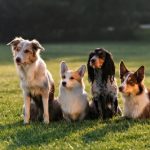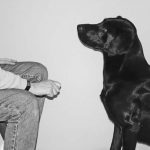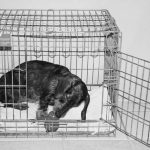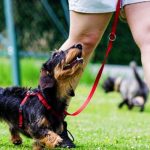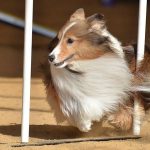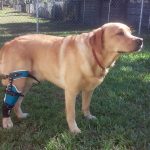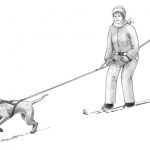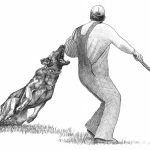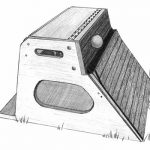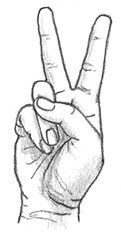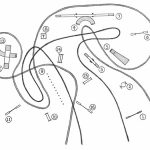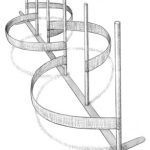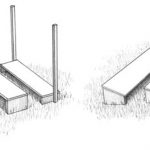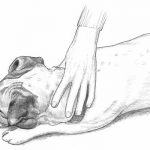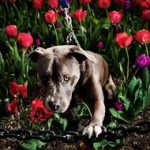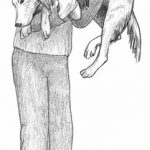- Explaining some of your dog’s curious behaviors
- Looking at a few behaviors you may wish they didn’t have
Who knows why your dog does some of the things that he does? Or more important, who wants to know why your dog does some of the things that he does? Well, if you’re curious, this chapter offers answers to a few of these critical questions.
Why Do Dogs Insist on Jumping on People?
The behavior goes back to the weaning process. As puppies grow, the mother dog begins to feed them standing up, so puppies have to stand on their hind legs to feed. Then, as her milk decreases, the puppies jump up to lick at the corner of her mouth, trying to get her to regurgitate her semidigested meal. When she does, it’s the puppies’ first introduction to solid food.
As dogs grow, jumping becomes more of a greeting behavior, as in, “Hi, good to see you,” much like people shake hands when they meet someone. Because the behavior is so instinctive, modifying it is sometimes difficult. Although you’re probably pleased that your dog is happy to see you, you’d also probably prefer a more sedate greeting, especially if Buddy is a large dog. And, because jumping up on people is a friendly gesture, we suggest modifying the behavior in a positive way (see Chapter
Mastering Basic Training).
Why Do Dogs Sniff Parts of Your Anatomy That You’d Prefer They Didn’t?
When two dogs meet each other for the first time, they often go through what looks like a choreographed ritual. After some preliminaries, they sniff each other’s respective rear ends and genitals. Dogs “see” with their noses and gather important information in this way. They can identify the dog’s gender, age, and rank order, information that dictates how they interact with each other.
When meeting a new person, a dog wants to know that same information. Some are confirmed “crotch sniffers,” while others are more subtle. Although embarrassing for the owner and the “sniffee,” the behavior is harmless enough and easily remedied with the “Sit” command.
Why Do Male Dogs Lift Their Leg So Often?
All dogs mark their territory by leaving small amounts of urine, the male more so than the female. You can liken it to putting up a fence; it lets other dogs in the neighborhood know he has been there. The scent enables dogs to identify the age, gender, and rank order of every dog that has marked that spot.
When you take Buddy for a walk, he intently investigates various spots and then lifts his leg to deposit a few drops of urine to cover the area, thereby reclaiming his territory. Male dogs also have a special fondness for vertical surfaces, such as a tree or the side of a building. Corners of buildings are a special treat. Height is important because it establishes rank. Comical contortions can be the result, such as when a Yorkshire Terrier tries to cover the mark of a Great Dane. Females don’t seem to have that need, which explains why they can do their business in a fraction of the time it takes a male.
Both males and females may also scratch at the ground and kick the dirt after urinating to spread their scent, thereby claiming a larger amount of territory.
Why Do Dogs Mount Each Other?
Both female and male dogs can display mounting behavior. More normally associated with males trying to flirt or breed a female, this behavior can be seen male to male, female to female, and female to male. Most people think it has to do only with sex, but it can be a dominance display with dogs of the same gender — the one on top reminding the other who is in charge — or it can be a behavior that is displayed when dogs that know each other well have been separated for some time. The behavior is then a form of bonding, like a hug, meaning, “I missed you.” Instead of discouraging this behavior, we have found it better to leave the dogs alone; they work things out well between themselves. They have to, because they’re pack animals and know exactly the message they’re trying to convey, usually to bring harmony back into the household.
Remember
The only time this mounting behavior can be construed as abnormal is if a female has some vaginal discharge indicating some sort of infection, which smells as if she is in season. In that case, other dogs won’t leave her alone, and a visit to the vet is the appropriate remedy.
Why Do Dogs Like to Chase Things?
Dogs chase things for a variety of different reasons:
– To chase intruders, be it people or other animals, off their property
– To chase a potential meal, such as a rabbit, squirrel, or chipmunk
– To chase just because the object is moving, such as cars, bicycles, or joggers
– To chase because it’s fun
Why Do Dogs Roll in Disgusting Things?
Dogs delight in rolling in the most disgusting stuff, such as dead fish, deer droppings, and similar decaying debris. To make matters worse, the urge to roll seems strongest just after Buddy has had a bath. Do dogs like to smell putrid?
Behaviorists believe that because the dog is a pack animal, he is merely bringing back to the pack the scent of possible food sources. The pack can then track down a meal. The behavior is instinctive. Most dogs roll at one point or another, some to a greater extent than others. It’s just part of being a dog.
Why Do Dogs Eat Weeds or Grass?
Dogs come with many instinctive behaviors. One of those behaviors is the incredible knowledge of what weeds to eat and when. One reason a dog eats grass is to induce vomiting. He may have eaten something that disagrees with him, and the grass goes into the stomach and binds whatever it contains, which is then expelled. It’s an adaptive behavior that protects the dog against indigestion and food poisoning. As a result, dogs that have access to the right kind of grasses, those with wide, serrated edges, rarely get food poisoning. Another reason dogs eat grass, wheat grass, for example, is as a digestive aid.
Remember
Dogs have an infallible knowledge of which weeds to eat. These weeds are often the very same that are found in capsules in the health food store to boost immune systems or any other body system. Should you stop your dog from eating weeds? Absolutely not! He knows much better what he needs than you do. Just make sure you don’t expose your dog to areas that have been sprayed with chemicals.
Dogs also seem to have a sense of the medicinal value of various plants. When one of our Newfoundlands became arthritic, he would seek out the large patch of poison ivy we have on our property. During our daily walks, he would make it a point to stand in that patch for a few minutes, eat the grass that grew there, and then move on. At first we couldn’t understand his behavior. We subsequently discovered that Rhus Tox, a homeopathic remedy for achy joints and rheumatism, is made from poison ivy.
Why Do Dogs Eat Disgusting Things?
Good question.
Why Do Some Dogs Scoot on Their Rear Ends?
Remember
Once in a while, your dog may appear to be sitting and then suddenly drag himself around on his front paws, with his rear end on the floor. It looks as if he is trying to clean his rear. This can mean that his anal glands — small scent sacks just inside the rectum — are full and need emptying. When they need emptied, you need to take him to your vet so she can express the glands. With some breeds, these small glands have to be emptied a couple of times a month. With other breeds, you never see this behavior.
Another reason for this behavior is tapeworms. The segments of worm are pushed out through the rectum and irritate the dog. To rid himself of the segment, he’ll scrape his rectum on the carpet or on the grass outside. If you think your dog has worms, visit your vet and let her make a diagnosis.
Why Do Dogs Show Nesting Behavior?
Around eight or nine weeks after a female has come out of season, you may see her digging around her bed, turning in circles, collecting toys and putting them in her bed, and guarding the area from other animals and maybe even yourself. She’s preparing a nest for her puppies. Sometimes even spayed females exhibit this behavior, and it’s often accompanied by swelling of the mammary glands that may actually fill with milk.
In the wild, female dogs in a pack, even if they weren’t pregnant or didn’t have puppies, developed milk. This phenomenon ensures the survival of the litter in case something happens to the mother dog.
by Jack and Wendy Volhard



